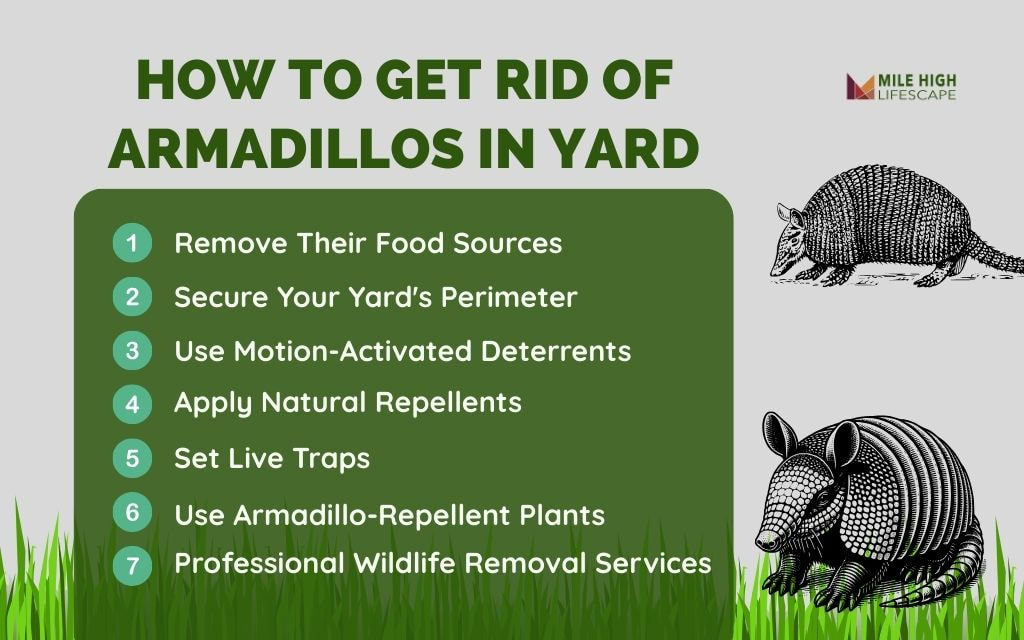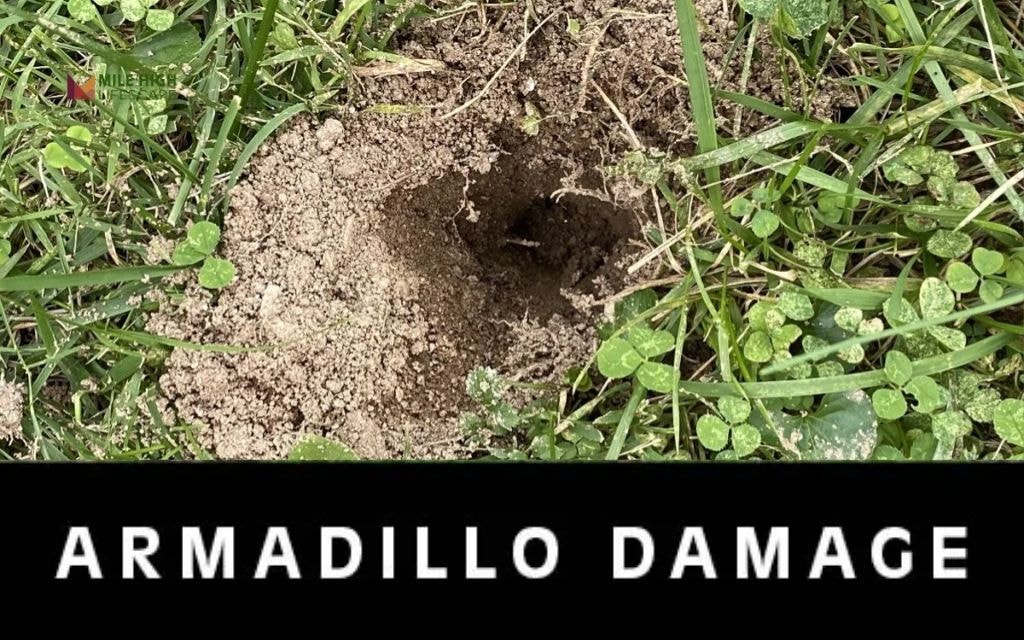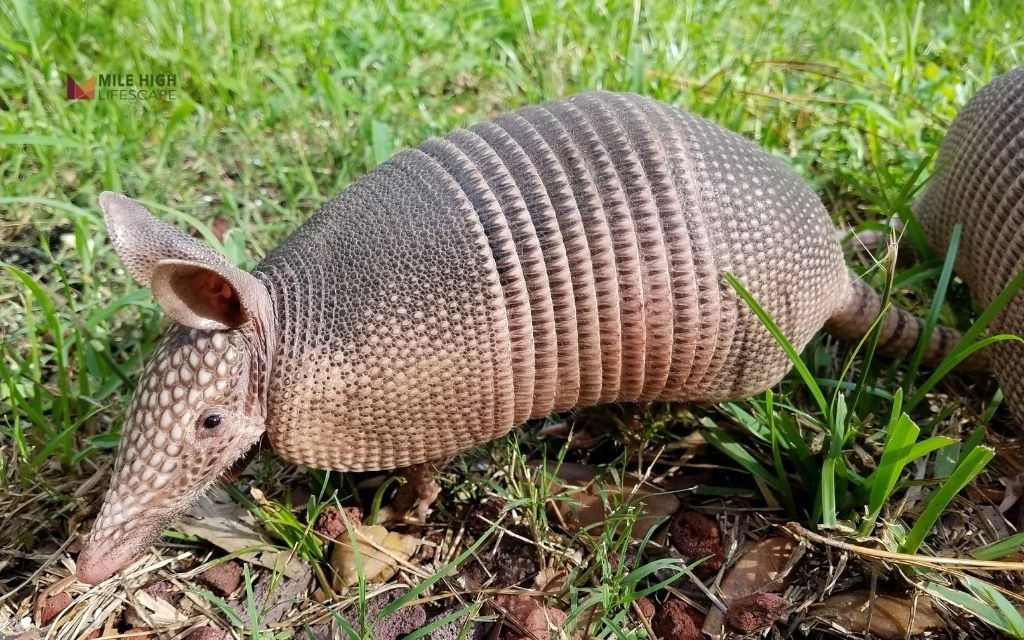Armadillos, once confined to southern regions, now expand their territory northward into Colorado. These nocturnal diggers create significant problems for homeowners through extensive yard damage, garden destruction, and potential structural risks to foundations.
The combination of warming Colorado winters and our irrigated landscapes creates ideal conditions for these adaptive creatures. In this guide, you’ll discover the primary causes of armadillo attraction to yards, how to recognize the signs of infestation, and proven armadillo control methods suited for Denver’s unique climate and soil.
This guide will help you stop armadillos from digging and damaging your property – for good.
How to Get Rid of Armadillos in Yard: 7 Effective Solutions
#1: Remove Their Food Sources
Eliminating the armadillo’s primary food supply creates immediate results. Apply professional-grade grub control treatments containing ingredients like imidacloprid or halofenozide to your lawn in early spring and fall.
These treatments target white grubs, earthworms, and soil-dwelling insects – the armadillo’s preferred diet – without harming beneficial microorganisms.
For organic options, apply beneficial nematodes (microscopic organisms that prey on grubs) when soil temperatures remain above 60°F. Water the area lightly before and after application to activate these natural predators.
#2: Secure Your Yard’s Perimeter
Install underground fencing using 1/4-inch hardware cloth or heavy-gauge metal mesh with a minimum depth of 18 inches. This physical barrier stops armadillos’ digging attempts, as they rarely excavate beyond one foot deep.
For maximum effectiveness, extend the fence material outward in an L-shape underground at a 90-degree angle, creating a horizontal barrier extending 12 inches.
Reinforce existing fences by burying barrier material along the fence line. Focus on gaps and weak points, especially near gates and corners where armadillos typically test defenses.
Close off potential shelter areas by sealing access to crawl spaces under decks, sheds, and patios with heavy-gauge wire mesh. Focus on gaps larger than 5 inches – the minimum size an armadillo needs to enter.
#3: Use Motion-Activated Deterrents
Install commercial-grade motion sensors connected to sprinklers with 180-degree spray patterns to cover maximum territory. Position these units 20-30 feet apart around your property’s perimeter, focusing on known entry paths. Modern systems allow programming for nighttime activation only, conserving water while targeting armadillos’ active hours.
Combine water deterrents with motion-activated LED floodlights positioned at ground level near burrow entrances and damage sites. The sudden illumination disorients armadillos’ poor vision, creating a discomforting environment.
Solar-powered units eliminate wiring requirements and function reliably through Denver’s 300+ annual days of sunshine.
#4: Apply Natural Repellents
Create an effective armadillo deterrent by mixing castor oil with dish soap (4 parts castor oil to 1 part soap) and diluting with water. Spray this solution around the perimeter of your yard and near known entry points. The solution penetrates the soil, creating an unpleasant taste and smell that drives armadillos away.
Place predator urine granules (available at garden centers) around the yard perimeter. The scent triggers armadillos’ natural fear response. Reapply these natural repellents after rain or irrigation cycles for consistent protection.

#5: Set Live Traps
Select heavy-duty live traps measuring at least 12″x12″x36″ with solid metal floors—armadillos can dig through wire-bottom traps. Position these along fence lines, near burrows, or along damaged areas where armadillo paths are visible. Camouflage traps with local vegetation to reduce the animals’ wariness.
Bait traps with overripe fruit, mealworms, or earthworms – foods armadillos find irresistible. Place the traps in shaded areas and check them every morning.
After capturing an armadillo, relocate it according to Colorado wildlife regulations. Transport the animal at least 5 miles away from your property to prevent return visits, preferably to suitable natural habitat away from residential areas.
#6: Use Armadillo-Repellent Plants
Install prickly vegetation like barberry, holly, or American agave around yard perimeters and vulnerable areas. These plants create living barriers that armadillos avoid due to their sensitive snouts and skin.
Integrate aromatic herbs with strong scents, including garlic, rosemary, lavender, sage, and mint. Plant these in clusters near entry points and damage-prone areas. Denver’s climate particularly supports these drought-resistant options, creating maintenance-friendly deterrents.
For maximum effectiveness, combine physical and aromatic barriers in tiered plantings.
Install larger prickly shrubs as the outer defense, followed by strongly-scented herbs as a secondary barrier. This layered approach creates multiple deterrent zones while enhancing your landscape’s aesthetic appeal.
#7: Professional Wildlife Removal Services
When DIY methods prove insufficient or infestations turn severe, Mile High Lifescape connects you with certified wildlife management professionals who specialize in armadillo control.
These experts employ advanced techniques including:
- Thermal imaging to identify active burrows and travel routes
- Customized exclusion systems designed for Denver’s unique soil conditions
- CO₂ detection to confirm burrow occupation before removal attempts
- Professional-grade repellent applications with commercial equipment
Professional services provide comprehensive solutions, addressing not only current armadillo problems but also implementing preventative measures tailored to your property’s specific vulnerabilities.
Technicians assess landscape features, drainage patterns, and soil conditions to develop targeted strategies that provide long-term protection.
Understanding Armadillos: What You Need to Know
- Behavior: Armadillos (primarily the nine-banded and occasional Mexican Long-Nosed) are nocturnal, foraging for grubs, earthworms, and insects. Their poor eyesight is balanced by a powerful sense of smell.
- Why Denver? Milder winters and irrigated, semi-arid lawns offer ideal conditions for burrowing and feeding.
- Property Risks: Armadillos are not aggressive towards humans or pets, but their digging causes yard damage and can undermine walkways, foundations, and patios.
Signs You Have an Armadillo in Your Yard
Identifying armadillo activity early allows for faster intervention. Watch for these telltale indicators:
Physical signs:
- Conical holes (1-3 inches wide) scattered across your lawn
- Uprooted plants and disturbed mulch beds with distinctive digging patterns
- Shallow tunnels near foundations, decks, and patios
- Small trenches along walkways or garden borders
Behavioral signs:
- Increased nighttime lawn activity (armadillos are primarily nocturnal)
- New damage appearing overnight around garden beds or irrigation systems
- Tracks showing three-toed footprints in soft soil or mud

What Not to Do When Dealing with Armadillos
Avoid these ineffective and potentially dangerous approaches:
- Do NOT use poisons: Poisoning armadillos violates Colorado wildlife regulations and presents dangers to pets, children, and other wildlife. Toxins often fail to reach armadillos and instead harm beneficial organisms in your soil.
- Do NOT flood tunnels: While seemingly logical, flooding armadillo burrows rarely works and often damages your lawn’s root systems. Excess water can also undermine foundations and create erosion problems.
- Do NOT handle armadillos directly: Though rare, armadillos can carry diseases transmissible to humans. Always use proper equipment when setting or checking traps, and wear gloves when handling any items that have contacted these animals.
How to Prevent Future Armadillo Problems in Denver
Implement these Denver-specific prevention strategies to maintain an armadillo-free yard:
- Maintain optimal soil moisture: Water deeply but infrequently, allowing soil to dry between irrigation cycles. This practice supports lawn health while discouraging the moist conditions armadillos prefer.
- Remove yard debris promptly: Fallen leaves, branches, and overgrown vegetation create ideal hiding spots for armadillos. Regular cleanup eliminates these shelter opportunities.
- Apply thin mulch layers: Keep mulch depth under 2 inches in garden beds. Thicker mulch harbors insects and provides comfortable digging material for armadillos.
- Install physical barriers: Place rock borders or buried hardware cloth around gardens and landscape features. These barriers prevent access to vulnerable areas without detracting from your landscape design.
- Schedule seasonal grub treatments: Coordinate treatments with key armadillo activity periods in spring and early fall. Professional applications target grubs before they attract armadillos to your property.

When to Call a Professional Wildlife Control Company
Contact wildlife management professionals when:
- Multiple armadillos appear on your property
- Tunnels approach your home’s foundation
- DIY methods fail after 2-3 weeks of consistent application
- Damage occurs in critical landscape areas
- You notice evidence of armadillo young
Mile High Lifescape connects Denver homeowners with specialized wildlife control experts who understand our region’s unique challenges. These professionals provide comprehensive solutions, from humane removal to landscape rehabilitation and long-term protection plans.
Conclusion
Effective armadillo management requires a multi-faceted approach combining removal techniques, physical barriers, repellents, and habitat modification. Early intervention significantly improves success rates, minimizing damage to your property and landscaping investment.
Denver’s changing climate means armadillos likely represent a continuing challenge for homeowners. Implementing comprehensive protection strategies now creates long-term defense against these persistent diggers.
Contact Mile High Lifescape at (303) 877-9091 to schedule a free consultation for wildlife-proof landscaping.
Our experts will assess your property’s vulnerability and develop customized solutions to protect your outdoor spaces from armadillo damage and other wildlife challenges.
Frequently Asked Questions (FAQs)
What smells do armadillos hate?
Armadillos strongly dislike the scents of castor oil, vinegar, ammonia, cayenne pepper, and predator urine. Their sensitive noses make these powerful odors effective deterrents when applied around your yard perimeter.
What makes armadillos go away?
To discourage armadillos from your property, eliminate their food sources through grub control, reduce soil moisture, install physical barriers, and apply natural repellents consistently. Combining these methods creates an inhospitable environment that drives armadillos to seek easier foraging elsewhere.
What time of night do armadillos come out?
Armadillos typically emerge around dusk and remain active throughout the night until early morning. Peak activity occurs between 2-5 hours after sunset, making this the optimal time for observation or trapping efforts.
What is the best armadillo repellent?
The best armadillo repellent combines castor oil, dish soap, and water in a spray solution that penetrates soil. This mixture creates both taste and smell barriers that effectively repel armadillos without harming your lawn or garden plants.
Do armadillos return to the same place?
Yes. Once armadillos find a suitable foraging spot, they normally will return repeatedly unless deterred. They establish regular feeding routes and may create multiple burrows within their territory, making comprehensive control measures necessary for complete removal.
